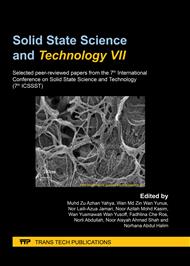[1]
M.D. Maksimović, V.B. Mišković-Stanković, The corrosion behaviour of epoxy-resin electrocoated steel, Corros. Sci. 33 (1992) 271-279.
DOI: 10.1016/0010-938x(92)90151-r
Google Scholar
[2]
I. Ismail, M.K. Harun, Adhesion failure of rubber/metal composites undergoing corrosion, Rubber Chem. Technol. 90 (2017) 455-466.
DOI: 10.5254/rct.16.83764
Google Scholar
[3]
I. Ismail, M.K. Harun, Cathodic disbonding of industrial chlorinated rubber-based primer used in rubber/metal composites: An electrochemical impedance spectroscopy analysis, Rubber Chem. Technol. 89 (2016) 712-723.
DOI: 10.5254/rct.16.83793
Google Scholar
[4]
M. Mahdavian, M. Attar, Evaluation of zinc phosphate and zinc chromate effectiveness via AC and DC methods, Prog. Org. Coat. 53 (2005) 191-194.
DOI: 10.1016/j.porgcoat.2005.02.007
Google Scholar
[5]
G. Pallos, G. Wallwork, Inhibition of pitting corrosion of mild steel in neutral solutions, Corrosion 38 (1982) 305-313.
DOI: 10.5006/1.3621690
Google Scholar
[6]
S.A. Umoren, M. M. Solomon, Protective polymeric films for industrial substrates: A critical review on past and recent applications with conducting polymers and polymer composites/nanocomposites, Prog. Mater. Sci. 104 (2019) 380-450.
DOI: 10.1016/j.pmatsci.2019.04.002
Google Scholar
[7]
N. Parhizkar, B. Ramezanzadeh, T. Shahrabi, Corrosion protection and adhesion properties of the epoxy coating applied on the steel substrate pre-treated by a sol-gel based silane coating filled with amino and isocyanate silane functionalized graphene oxide nanosheets, Appl. Surf. Sci., 439 (2018) 45-59.
DOI: 10.1016/j.apsusc.2017.12.240
Google Scholar
[8]
H. Vakili, B. Ramezanzadeh, R. Amini, The corrosion performance and adhesion properties of the epoxy coating applied on the steel substrates treated by cerium-based conversion coatings, Corros. Sci. 94 (2015) 466-475.
DOI: 10.1016/j.corsci.2015.02.028
Google Scholar
[9]
M. Izadi, T. Shahrabi, B. Ramezanzadeh, Active corrosion protection performance of an epoxy coating applied on the mild steel modified with an eco-friendly sol-gel film impregnated with green corrosion inhibitor loaded nanocontainers, Appl. Surf. Sci. 440 (2018) 491-505.
DOI: 10.1016/j.apsusc.2018.01.185
Google Scholar
[10]
K. Shalabi, A. Helmy, A. El-Askalany, M. Shahba, New pyridinium bromide mono-cationic surfactant as corrosion inhibitor for carbon steel during chemical cleaning: Experimental and theoretical studies, J. Mol. Liq. 293 (2019) 111480-111496.
DOI: 10.1016/j.molliq.2019.111480
Google Scholar
[11]
M. Migahed, A. Alsabagh, M. Abdou, A.-H. Adel, A.A. Aboulrous, Synthesis a novel family of phosphonate surfactants and their evaluation as corrosion inhibitors in formation water, J. Mol. Liq. 281 (2019) 528-541.
DOI: 10.1016/j.molliq.2019.02.093
Google Scholar
[12]
M. Deyab, Effect of cationic surfactant and inorganic anions on the electrochemical behavior of carbon steel in formation water, Corros. Sci. 49 (2007) 2315-2328.
DOI: 10.1016/j.corsci.2006.10.035
Google Scholar
[13]
S.A. Umoren, M.M. Solomon, Synergistic corrosion inhibition effect of metal cations and mixtures of organic compounds: A Review, J. Environ. Chem. Eng. 5 (2017) 246-273.
DOI: 10.1016/j.jece.2016.12.001
Google Scholar
[14]
Y. Qiang, S. Zhang, L. Guo, S. Xu, L. Feng, I. B. Obot, S. Chen, Sodium dodecyl benzene sulfonate as a sustainable inhibitor for zinc corrosion in 26% NH4Cl solution, J. Clean. Prod. 152 (2017) 17-25.
DOI: 10.1016/j.jclepro.2017.03.104
Google Scholar
[15]
J.-Y. Sha, H.-H. Ge, C. Wan, L.-T. Wang, S.-Y. Xie, X.-J. Meng, Y.-Z. Zhao, Corrosion inhibition behaviour of sodium dodecyl benzene sulphonate for brass in an Al2O3 nanofluid and simulated cooling water, Corros. Sci. 148 (2019) 123-133.
DOI: 10.1016/j.corsci.2018.12.006
Google Scholar
[16]
I. Ismail, M. K. Harun, M. Z. A. Yahya, Enhance corrosion protection of mild steel by the synergetic effect of sodium dodecylbenzenesulfonates and zinc sulfate in sodium chloride solution, Int. J. Electrochem. Sci. 14 (2019) 11491-11508.
DOI: 10.20964/2019.12.20
Google Scholar
[17]
J. Liu, D. Wang, L. Gao, D. Zhang, Synergism between cerium nitrate and sodium dodecylbenzenesulfonate on corrosion of AA5052 aluminium alloy in 3 wt. % NaCl solution, Appl. Surf. Sci. 389 (2016) 369-377.
DOI: 10.1016/j.apsusc.2016.07.107
Google Scholar
[18]
B. Zhou, Y.S. Wang, Y. Zuo, Evolution of the corrosion process of AA 2024-T3 in an alkaline NaCl solution with sodium dodecylbenzenesulfonate and lanthanum chloride inhibitors, Appl. Surf. Sci. 357 (2015) 735–744.
DOI: 10.1016/j.apsusc.2015.09.093
Google Scholar
[19]
S. Nikpour, R. Naderi, M. Mahdavain, Synergistic effect of Mentha longifolia and zinc cations in silane primer coating to improve protection properties of the subsequent epoxy coating, Prog. Org. Coat. 127 (2019) 55-69.
DOI: 10.1016/j.porgcoat.2018.11.007
Google Scholar
[20]
B.A. Rao, M.V. Rao, S.S. Rao, B. Sreedhar, Synergistic effect of N, N-bis (phosphonomethyl) glycine and zinc ions in corrosion control of carbon steel in cooling water systems, Chem. Eng. Commun. 198 (2011) 1505-1529.
DOI: 10.1080/00986445.2010.525200
Google Scholar
[21]
I. Ismail, M.K. Harun, M.Z.A. Yahya, Effects of dissolved oxygen on the integrity of industrial chlorinated rubber-based primer used in rubber/metal composites, Rubber Chem. Technol. 88 (2015) 502-514.
DOI: 10.5254/rct.15.84905
Google Scholar
[22]
S. Alinejad, R. Naderi, M. Mahdavian, Effect of inhibition synergism of zinc chloride and 2-mercaptobenzoxzole on protective performance of an ecofriendly silane coating on mild steel, J. Ind. Eng. Chem. 48 (2017) 88-98.
DOI: 10.1016/j.jiec.2016.12.024
Google Scholar
[23]
B. Qian, B. Hou, M. Zheng, The inhibition effect of tannic acid on mild steel corrosion in seawater wet/dry cyclic conditions, Corros. Sci. 72 (2013) 1-9.
DOI: 10.1016/j.corsci.2013.01.040
Google Scholar
[24]
N. V. Murillo-Gutiérrez, F. Ansart, J. P. Bonino, S. R. Kunst, C. F. Malfatti, Architectural optimization of an epoxy-based hybrid sol–gel coating for the corrosion protection of a cast Elektron21 magnesium alloy, Appl. Surf. Sci. 309 (2014) 62-73.
DOI: 10.1016/j.apsusc.2014.04.169
Google Scholar
[25]
J. Creus, H. Mazille, H. Idrissi, Porosity evaluation of protective coatings onto steel through electrochemical techniques, Surf. Coat. Tech. 130 (2000) 224-232.
DOI: 10.1016/s0257-8972(99)00659-3
Google Scholar


